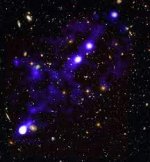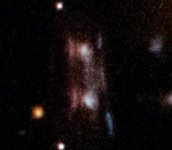I think you mean recipe?
Unless you have paid for Pete's meal! 😉
Fark 🙂
//
Sure, it's very basic and intuitive.Receipt please!?
//
1) pre-heat oven to 380F
2) sear said shanks in fry pan on stove top, then set in large roasting pan.
3) a few carrots, couple sticks of celery, a red bell pepper, a large cooking onion, three average size cloves of fresh garlic, about ten mushrooms, nicely arranged throughout and around the shanks.
4) 1/2 teaspoon black pepper, 1/2 teaspoon caraway seeds, 1 heaping tablespoon Hungarian paprika, about four or five sprigs of fresh rosemary, about the same amount of fresh basil, salt as you see fit.
5) about a litre of V8 juice poured in first finished with water until the shanks are visibly immersed about 2/3 in liquid.
6) cook covered for anywhere from 1.5 to 2 hrs, checking in about a good hour to baste.
7) with your fav: pasta, rice, potatoes, etc.
8) celebrate with fav libation

You mean that the linear velocity (v) at the equator can approach the speed of light.
v = r ω (where r = the radius of the star and ω is its angular velocity).
I've seen one example of the linear velocity of a neutron star at its equator - 70,000 km per second or approximately 24% of the speed of light.
Yes, that’s the same figure I am aware of. Keep in mind this thing is only a few 10’s of km in diameter :O
I'de like to know more, I do not see how spinning can do something to the light bending; So far in my understanding, only comes in, the mass.
Steven Hawking described spacetime in the vicinity of a BH as being ‘foamy’. The curvature is so great and I gather not particularly ‘smooth’ so photons passing nearby are going to be bent and curved all over the place.
For the Sneppen paper, a more prosaic example to help visualize it would be when you look down a plug hole as water is draining. You often get a ring of light that changed in shape and size as it is reflected off the surface of the water.
I just wanted to provide you with some evidentiary backup. There are doubters in our midst.
😀
😀
There is mounting evidence that filaments of dark matter connect galaxies and galactic clusters together like a vast, cosmic web.
It is conjectured that hydrogen flows along these strands, feeding into the galaxies.
Earlier this year astronomers finally imaged the faint emission from diffuse hydrogen in intergalactic space, providing the strongest indirect evidence yet for the existence of dark matter filaments.
Groundbreaking New Images of Cosmic Web Strands Revealed by Astronomers
Now, astronomers have suggested that filaments of dark matter are partly responsible for the gravitational lensing that produces two identical images of a distant galaxy known as Hamilton's object.
Mystery solved! Bizarre Hubble double galaxy caused by 'ripple' in space | Space
It is conjectured that hydrogen flows along these strands, feeding into the galaxies.
Earlier this year astronomers finally imaged the faint emission from diffuse hydrogen in intergalactic space, providing the strongest indirect evidence yet for the existence of dark matter filaments.
Groundbreaking New Images of Cosmic Web Strands Revealed by Astronomers
Now, astronomers have suggested that filaments of dark matter are partly responsible for the gravitational lensing that produces two identical images of a distant galaxy known as Hamilton's object.
Mystery solved! Bizarre Hubble double galaxy caused by 'ripple' in space | Space
Attachments
Faint ripples in the fabric of space time. Matter (mostly H in this case) will congregate where time runs more slowly relative to surrounding space time.
The question remains why, since there are no large congregations of matter to cause this effect in the vicinity.
The question remains why, since there are no large congregations of matter to cause this effect in the vicinity.
I don't quite follow your statement. By "space time" do you mean spacetime (space-time)?Matter ... will congregate where time runs more slowly relative to surrounding space time.
Relativity says that time will speed up and slow down depending on the mass and velocity of the surrounding matter.
You seem to be stating that principle in reverse. 😕
Yes, there is this effect in the GPS satellites. This is enough to ask for a must correction.Atomic clocks run more slowly in the presence of a gravity field
Atomic clocks run more slowly in the presence of a gravity field
I'd question that statement. My understanding is the clocks run more slowly further down the Gravity POTENTIAL. A subtle difference.
What Albert Sneppen seems to suggest is that spinning Black Holes impart Angular Momentum to nearby objects, especially when near the event horizon.
This is hard to grasp in terms of a classical theory of fields in Space-Time. The edge going away from you behaves differently from the edge coming towards you in bending light.
We now have straightforward Gravitation attraction, Tidal Forces and Spinning Forces to conceive. 😕
I don't find the non-spinning Black Hole hard.
Clearly just some sort of angle-preserving Conformal Transformation:
A 100% reflecting sphere isn't really much different from a 100% absorbing sphere. Just inverses of each other, one feels.
Conformal mappings work in Electrostatics too:
No, it's the spin component that I am finding difficult. Must be a Lorentz transform thing.
- Status
- Not open for further replies.
- Home
- Member Areas
- The Lounge
- What is the Universe expanding into..





